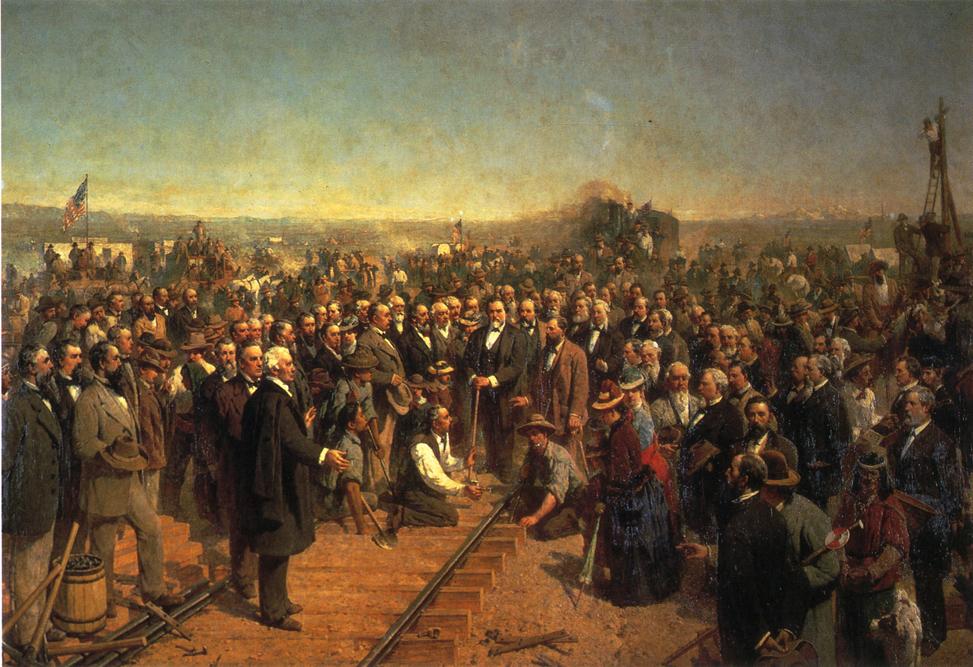The first transcontinental railroad was 1,912 miles long, and was built to connect the east and the west coasts of the United States. It was commissioned by Congress in 1862. In the 1850s Congress saw that an effective rail network connecting the east to the west was needed to help with the rapid westward settlement. Before the Civil War, Congress needed to find the best route to the Pacific, so it commissioned a number of surveyors. Both Northern states and Southern states wanted the route to begin in their regions, which kept the Senate from being able to pass any legislation on the transcontinental railroad until the Southern states seceded from the Union in 1861. With the absence of Southern legislators from Congress, the northern route to the Pacific now met with little opposition. On July 1, 1862, the Pacific Railway Act became law and it offered incentives to men who were willing to help develop this first transcontinental railway. The two railway companies that were authorized to construct the rail network was the Union Pacific and the Central Pacific Railroad Companies. They were given government bonds and vast land grants.1
The Central Pacific was founded in 1861 by a group of California merchants known as the big four: Collis P. Huntington, Leland Stanford, Mark Hopkins, and Charles Crocker. They were best known for building the part of the transcontinental railroad that started in Sacramento, California, with Huntington representing the company in the East, handling the financing and purchasing aspects, and acting as a lobbyist. Crocker was in charge of the construction aspects, and Stanford, who was the governor of California in 1862–63, saw to the company’s financial and political interests in the West. To see to their need for labor, they employed thousands of Chinese laborers who made up between 80-90% of the Central Pacific work force, to work their way through the Sierra Nevada mountain range to meet the Union Pacific on the other side.2

With the Central Pacific building from the west, the Union Pacific was building from the east to meet up with them. The Union Pacific was incorporated by the Pacific Railway Act as well. It built 1,006 miles of track westward from Omaha Nebraska to meet the Central Pacific in Promontory, Utah, on May 10, 1869. Federal loans and land grants largely financed the company, like the Central Pacific, but the Union Pacific became embroiled in scandal when its financial branch, the Crédit Mobilier, was discovered to have individuals amassing enormous amounts of profits at the public expense. After discovery of this scandal of government funds, it almost destroyed the company. It still had a huge amount of debt in 1893, when it went under new ownership.3

Despite the scandal, the first transcontinental railroad was finally connected at Promontory, Utah on May 10, 1869 with an elaborate ceremony. Thomas Durant of the Union Pacific and governor Stanford of the Central Pacific took turns hammering the final “golden spike” into the ties that united the railways. As the celebration ended and the railroad was open for business, the impact was felt immediately as the travel time between the east and west was dramatically reduced from a few months to a simple week or less.4 The impact that this had on the United States was significant. It shortened the travel time and expanded interstate trade. It helped to spread ideas, and it also helped spread American culture, as the American people saw manifest destiny take on a very real form.
- Gale Encyclopedia of American Law, 2010, s.v. “Pacific Railroad Act,” edited by Donna Batten. ↵
- Development of the Industrial U. S. Reference Library, 2006, s.v. “Biographies,” Eds. Sonia G. Benson, Jennifer York Stock, and Carol Brennan. ↵
- Gale Encyclopedia of U.S. Economic History, 2000, s.v. “Union Pacific Railroad Company.” ↵
- Dictionary of American History, 2003, s.v. “Promontory Point,” by Oscar Osbur Winther. ↵



42 comments
Nataly Solis Chavez
I found this article to be very good. The content and the flow was very well organised making everything clear and concise. It’s interesting how both the North and the South wanted for the transcontinental railroad to start near them which is why it hindered the process. I remember reading books about this in high school as well but you made it appealing, nicely done.
Mario De Leon
Very informative article on the first transcontinental railroad. The introduction paragraph gave some good quick background information on the railroad. The development of this railroad changed America and helped it become what America is today so I think this is a very important article to read. I did not know about the scandal that was involved with Union Pacific, and now I am going to do more research into the scandal.
Natalia Zuniga
It was really surprising to find out that that it was the Chinese that took up most of the construction for the railroad. It is strange to see how important the railroad was to the country back then and for a good reason compared to now. Most people nowadays have never been on a train to see or even ride for transportation.
Briana Bustamante
I truly enjoyed your presentation on the Transcontinental Railroad. It was interesting and informative. I was unaware of the financial difficulties behind the scenes. The fact that there were so many Asian workers working on the railway was also interesting. Thank you for providing the picture of the workers hammering in the golden spikes. You did an excellent job on your presentation.
Irene Astran
This was a good article. I found it interesting that so many Chinese laborers were enlisted to work on this railroad. Immigrants have been taking on the toughest American projects since the beginning of time! Maybe not all willingly, but nevertheless they have been doing the back breaking work. I would enjoy to hear more about the experiences of the workers during this time.
Aaron Jaramillo
Wow great article Justin! It was very interesting and very informative. Your article followed very well and was easy to read. Your images really attracted me at first. The railroad was a huge positive effect in history. While reading your article I learned thing that I didn’t know about the railroads. Great job Justin I’m looking forward to read more articles from you.
Aaron Mcglown
A short and very informative article. we went over the railroad in high school but i never knew that it took 16 years for it to be built. Thats a long time to be doing one task but look at the effects in the long run. it was a step forward in transportation in America. This article was well worth the read!
Steven Clinton
Great article. The building of transcontinental Railroad help feed the belief of manifest destiny. With the development of the railroad the mid-West and West were able to develop faster. Overall this article was very informative but it didn’t feel like it was overload with information. This sources were plentiful and good so of course the article was detailed. Great Article!
Zaraly Frasquillo
I really enjoyed your article because it’s about something many people would find boring or something that isn’t very important. But it is! It is super important the transcontinental railroad changed everything! To be able to cross the country in a week or so rather than a few months?! That’s amazing, honestly this article makes me proud to be an American! You did a great job organizing the article too! Thank you!
Hayden Hollinger
I really enjoyed reading this article, it surprised me how interesting it actually was. This article was very informative and I enjoyed learning some of the facts of the railroad that I previously never knew. It is incredible to think they spent 16 years building it and it is unbelievable to think how far we’ve come in terms of engineering and technology since then!